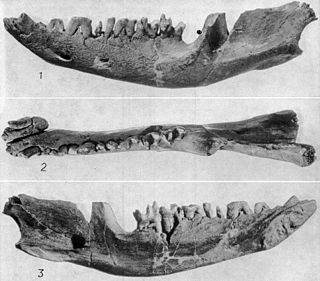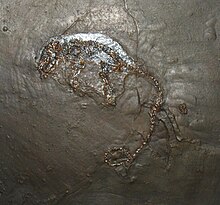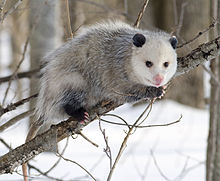
Marsupials are a diverse group of mammals belonging to the infraclass Marsupialia. They are primarily found in Australasia, Wallacea, and the Americas. One of the defining features of marsupials is their unique reproductive strategy, where the young are born in a relatively undeveloped state and then nurtured within a pouch.

Multituberculata is an extinct order of rodent-like mammals with a fossil record spanning over 130 million years. They first appeared in the Middle Jurassic, and reached a peak diversity during the Late Cretaceous and Paleocene. They eventually declined from the mid-Paleocene onwards, disappearing from the known fossil record in the late Eocene. They are the most diverse order of Mesozoic mammals with more than 200 species known, ranging from mouse-sized to beaver-sized. These species occupied a diversity of ecological niches, ranging from burrow-dwelling to squirrel-like arborealism to jerboa-like hoppers. Multituberculates are usually placed as crown mammals outside either of the two main groups of living mammals—Theria, including placentals and marsupials, and Monotremata—but usually as closer to Theria than to monotremes. They are considered to be closely related to Euharamiyida and Gondwanatheria as part of Allotheria.

Opossums are members of the marsupial order Didelphimorphia endemic to the Americas. The largest order of marsupials in the Western Hemisphere, it comprises 126 species in 18 genera. Opossums originated in South America and entered North America in the Great American Interchange following the connection of North and South America.

Metatheria is a mammalian clade that includes all mammals more closely related to marsupials than to placentals. First proposed by Thomas Henry Huxley in 1880, it is a more inclusive group than the marsupials; it contains all marsupials as well as many extinct non-marsupial relatives. It is one of two groups placed in the clade Theria alongside Eutheria, which contains the placentals.

Didelphodon is a genus of stagodont metatherians from the Late Cretaceous of North America.

Eodelphis, from eo- plus [Di]delphis, thus meaning "very early opossum", is a genus of stagodont metatherians from the Late Cretaceous of North America, with distinctive crushing dentition. Named species include E. browni and the more advanced E. cutleri. Both come from the Late Campanian of Dinosaur Provincial Park, Alberta. Specimens are also known from the Judith River Formation of Montana. E. cutleri is related to the Maastrichtian genus Didelphodon as indicated by its enlarged premolars and more robust jaw. Eodelphis was probably an aquatic predator like its relative Didelphodon, and may have weighed about 0.6 kg (1.3 lb), making it one of the largest mammals of its time.

Deltatheridium is an extinct species of metatherian. It lived in what is now Mongolia during the Upper Cretaceous, circa 80 million years ago. A study in 2022 strongly suggested that Deltatherium was a marsupial, making it the earliest known member of this group.

Bisonalveus is an extinct genus of shrew-like mammals that were presumably ground-dwelling and fed on plants and insects. Bisonalveus fossils have been discovered in the upper Great Plains region of North America, including sites in modern-day Wyoming, North Dakota, Montana, and Alberta. The fossils have been dated to 60 million years ago, during the Tiffanian North American Stage of the Palaeocene epoch. Bisonalveus is the last known genus of the Pentacodontinae sub-family to have arisen, replacing the genus Coriphagus in the early Tiffanian. Bisonalveus itself appears to have gone extinct by the middle Tiffanian.

Sparassodonta is an extinct order of carnivorous metatherian mammals native to South America, related to modern marsupials. They were once considered to be true marsupials, but are now thought to be a separate side branch that split before the last common ancestor of all modern marsupials. A number of these mammalian predators closely resemble placental predators that evolved separately on other continents, and are cited frequently as examples of convergent evolution. They were first described by Florentino Ameghino, from fossils found in the Santa Cruz beds of Patagonia. Sparassodonts were present throughout South America's long period of "splendid isolation" during the Cenozoic; during this time, they shared the niches for large warm-blooded predators with the flightless terror birds. Previously, it was thought that these mammals died out in the face of competition from "more competitive" placental carnivorans during the Pliocene Great American Interchange, but more recent research has showed that sparassodonts died out long before eutherian carnivores arrived in South America. Sparassodonts have been referred to as borhyaenoids by some authors, but currently the term Borhyaenoidea refers to a restricted subgroup of sparassodonts comprising borhyaenids and their close relatives.

Alphadon is an extinct genus of small, primitive mammal that was a member of the metatherians, a group of mammals that includes modern-day marsupials. Its fossils were first discovered and named by George Gaylord Simpson in 1929.

Herpetotherium is an extinct genus of metatherian mammal, belonging to the possibly paraphyletic family Herpetotheriidae. Native to North America from the Eocene to Early Miocene, fossils have been found in California, Oregon, Texas, Florida, Montana, Wyoming, Colorado, North and South Dakota, Nebraska, and Saskatchewan. The oldest species, H. knighti, is dated to around 50.3 mya, and the most recent, an unnamed species, may be as recent as 15.97 mya. A morphological analysis of marsupials and basal metatherians conducted in 2007 found Herpetotherium to be the sister group to extant marsupials. It is the youngest known metatherian from North America until the migration of the Virginia opossum from South America within the last 2 million years.

Herpetotheriidae is an extinct family of metatherians, closely related to marsupials. Species of this family are generally reconstructed as terrestrial, and are considered morphologically similar to modern opossums. Fossils of herpetotheriids come from North America, Asia, Europe, Africa, and perhaps South America. The oldest representative is Maastrichtidelphys from the latest Cretaceous (Maastrichtian) of the Netherlands and the youngest member is Amphiperatherium from the Middle Miocene of Europe. The group has been suggested to be paraphyletic, with an analysis of petrosal anatomy finding that North American Herpetotherium was more closely related to marsupials than the European Peratherium and Amphiperatherium.

Deltatheroida is an extinct group of basal metatherians that were distantly related to modern marsupials. The majority of known members of the group lived in the Cretaceous; one species, Gurbanodelta kara, is known from the late Paleocene (Gashatan) of China. Their fossils are restricted to Central Asia and North America. This order can be defined as all metatherians closer to Deltatheridium than to Marsupialia.

The Nacimiento Formation is a sedimentary rock formation found in the San Juan Basin of western New Mexico. It has an age of 61 to 65.7 million years, corresponding to the early and middle Paleocene. The formation has yielded an abundance of fossils from shortly after the Cretaceous-Paleogene extinction event that provide clues to the recovery and diversification of mammals following the extinction event.

Siamoperadectes is a genus of non-marsupial metatherian from the Miocene of Thailand. A member of Peradectidae, it is the first member of its clade known from South Asia, and among the last non-marsupial metatherians.
The "Gurlin Tsav" skull is a currently unnamed carnivorous metatherian fossil from the Nemegt Formation of Mongolia. Composed of a single semi-complete skull, this specimen is notable in regards to the evolution and systematics of Metatheria as a whole, and thus nigh-omnipresent in phylogenetic analyses of this group.

Gypsonictops is an extinct genus of leptictidan mammals of the family Gypsonictopidae, which was described in 1927 by George Gaylord Simpson. Species in this genus were small mammals and the first representatives of the order Leptictida, that appeared during the Upper Cretaceous.
Ernestokokenia is an extinct genus of mammal, belonging to the Didolodontidae. It lived during the Early Eocene and the Middle Eocene, and its fossils were discovered in South America.

Amphiperatherium is an extinct genus of metatherian mammal, closely related to marsupials. It ranged from the Early Eocene to the Middle Miocene in Europe. It is the most recent metatherian known from the continent.

Peradectidae is a family of small metatherian mammals, spanning from the Paleocene to the Miocene. Fossils are known from the Northern Hemisphere, including Europe, Asia and North America. The monophyly of the group has been questioned, with some authors suggesting that Peradectes should be the only genus placed in the family. The morphology of peradectids has been considered to be similar to opossums. Phylogenetic analysis suggest that they are less closely related to modern marsupials than herpetotheriids are.























